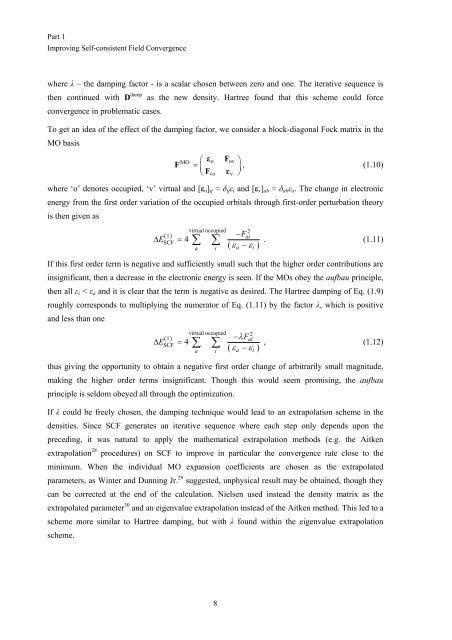Get my PhD Thesis
Get my PhD Thesis
Get my PhD Thesis
Create successful ePaper yourself
Turn your PDF publications into a flip-book with our unique Google optimized e-Paper software.
Part 1<br />
Improving Self-consistent Field Convergence<br />
where λ – the damping factor - is a scalar chosen between zero and one. The iterative sequence is<br />
then continued with D damp as the new density. Hartree found that this scheme could force<br />
convergence in problematic cases.<br />
To get an idea of the effect of the damping factor, we consider a block-diagonal Fock matrix in the<br />
MO basis<br />
F<br />
MO<br />
⎛ εo<br />
Fov<br />
⎞<br />
= ⎜ ⎟ , (1.10)<br />
⎝Fvo<br />
εv<br />
⎠<br />
where ‘o’ denotes occupied, ‘v’ virtual and [ε o ] ij = δ ij ε i and [ε v ] ab = δ ab ε a . The change in electronic<br />
energy from the first order variation of the occupied orbitals through first-order perturbation theory<br />
is then given as<br />
virtual occupied 2<br />
( 1)<br />
−Fai<br />
SCF<br />
4<br />
a i<br />
εa<br />
− εi<br />
∆ E =<br />
∑ ∑ . (1.11)<br />
( )<br />
If this first order term is negative and sufficiently small such that the higher order contributions are<br />
insignificant, then a decrease in the electronic energy is seen. If the MOs obey the aufbau principle,<br />
then all ε i < ε a and it is clear that the term is negative as desired. The Hartree damping of Eq. (1.9)<br />
roughly corresponds to multiplying the numerator of Eq. (1.11) by the factor λ, which is positive<br />
and less than one<br />
virtual occupied 2<br />
( 1)<br />
−λFai<br />
SCF<br />
4<br />
a i<br />
εa<br />
− εi<br />
∆ E =<br />
∑ ∑ , (1.12)<br />
( )<br />
thus giving the opportunity to obtain a negative first order change of arbitrarily small magnitude,<br />
making the higher order terms insignificant. Though this would seem promising, the aufbau<br />
principle is seldom obeyed all through the optimization.<br />
If λ could be freely chosen, the damping technique would lead to an extrapolation scheme in the<br />
densities. Since SCF generates an iterative sequence where each step only depends upon the<br />
preceding, it was natural to apply the mathematical extrapolation methods (e.g. the Aitken<br />
extrapolation 28 procedures) on SCF to improve in particular the convergence rate close to the<br />
minimum. When the individual MO expansion coefficients are chosen as the extrapolated<br />
parameters, as Winter and Dunning Jr. 29 suggested, unphysical result may be obtained, though they<br />
can be corrected at the end of the calculation. Nielsen used instead the density matrix as the<br />
extrapolated parameter 30 and an eigenvalue extrapolation instead of the Aitken method. This led to a<br />
scheme more similar to Hartree damping, but with λ found within the eigenvalue extrapolation<br />
scheme.<br />
8

















